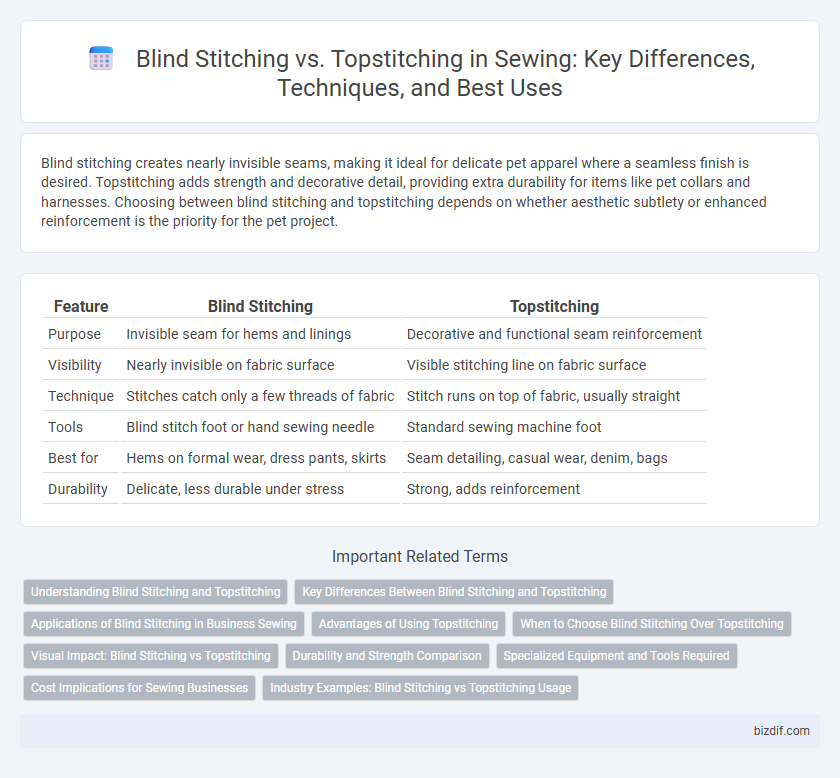Blind stitching creates nearly invisible seams, making it ideal for delicate pet apparel where a seamless finish is desired. Topstitching adds strength and decorative detail, providing extra durability for items like pet collars and harnesses. Choosing between blind stitching and topstitching depends on whether aesthetic subtlety or enhanced reinforcement is the priority for the pet project.
Table of Comparison
| Feature | Blind Stitching | Topstitching |
|---|---|---|
| Purpose | Invisible seam for hems and linings | Decorative and functional seam reinforcement |
| Visibility | Nearly invisible on fabric surface | Visible stitching line on fabric surface |
| Technique | Stitches catch only a few threads of fabric | Stitch runs on top of fabric, usually straight |
| Tools | Blind stitch foot or hand sewing needle | Standard sewing machine foot |
| Best for | Hems on formal wear, dress pants, skirts | Seam detailing, casual wear, denim, bags |
| Durability | Delicate, less durable under stress | Strong, adds reinforcement |
Understanding Blind Stitching and Topstitching
Blind stitching creates nearly invisible seams by catching only a few threads of the fabric on the underside, making it ideal for hemming garments without visible stitches. Topstitching runs along the fabric's right side, providing decorative and functional reinforcement while enhancing seam durability. Understanding the distinct purposes and techniques of blind stitching and topstitching ensures tailored finishes and professional garment construction.
Key Differences Between Blind Stitching and Topstitching
Blind stitching is a technique where stitches are concealed on the fabric's right side, making it ideal for hems and invisible seams, while topstitching involves visible stitching on the garment's surface to reinforce seams and add decorative detail. Blind stitching uses specialized machines or hand sewing to catch only the fabric's edge, providing a clean finish without altering the garment's appearance, whereas topstitching requires precision to enhance strength and style with contrasting or matching thread. The key differences lie in visibility, purpose, and application, with blind stitching prioritizing invisibility for functional seams and topstitching focusing on durability and aesthetic enhancement.
Applications of Blind Stitching in Business Sewing
Blind stitching is widely used in business sewing for hemming garments where a clean, invisible finish is essential, such as in formal wear, bridal gowns, and high-end apparel. This technique allows manufacturers to maintain a polished appearance without visible stitches, enhancing product quality and customer appeal. Its application is crucial for luxury brands aiming to combine durability with aesthetic subtlety in mass production.
Advantages of Using Topstitching
Topstitching enhances garment durability by reinforcing seams, making them less prone to wear and tear. It provides a decorative element that adds visual appeal and professional finish to clothing, elevating the overall design. The technique also helps in flattening seam allowances, improving garment structure and comfort.
When to Choose Blind Stitching Over Topstitching
Blind stitching is ideal for hemming garments or fabrics where the stitch should remain invisible on the right side, such as formal wear or curtains, preserving a clean and polished appearance. It is preferred when maintaining the fabric's smooth surface and avoiding visible seams is crucial, unlike topstitching which is decorative and functional but clearly visible. Choosing blind stitching over topstitching enhances garment elegance and is essential in situations requiring discreet, professional finishes.
Visual Impact: Blind Stitching vs Topstitching
Blind stitching offers a nearly invisible seam, ideal for creating a clean and subtle finish on hems and delicate fabrics, preserving the garment's smooth appearance. Topstitching, by contrast, provides a visible row of stitching on the garment's surface, enhancing design elements with decorative and functional detail. The choice between blind stitching and topstitching significantly affects the garment's visual impact, balancing discreet elegance against pronounced style features.
Durability and Strength Comparison
Blind stitching offers discreet seams ideal for hems and delicate fabrics but generally provides less durability and strength compared to topstitching. Topstitching reinforces fabric edges with visible, strong stitches that resist wear and tear, making it preferable for high-stress areas like pockets and seams. For projects requiring enhanced seam longevity, topstitching is the superior choice due to its robust construction and increased fabric stability.
Specialized Equipment and Tools Required
Blind stitching requires a specialized blind stitch foot and sometimes a dedicated blind hem sewing machine to achieve nearly invisible hems, whereas topstitching demands a topstitch needle, heavier thread, and often a clear or edge stitch foot for precision and durability. Blind stitch machines use a unique mechanism that sews zigzag stitches catching only the fabric fold, while topstitching uses standard sewing machines capable of accommodating thicker threads and needles. Proper buttonhole scissors and clippers are also essential for finishing blind stitches, whereas topstitching benefits from marking tools to ensure straight, consistent stitching lines.
Cost Implications for Sewing Businesses
Blind stitching requires specialized machines and skilled labor, increasing upfront equipment and training costs for sewing businesses. Topstitching utilizes standard sewing machines and is quicker to execute, reducing overall labor expenses and production time. Choosing between these techniques directly impacts operational budgets and pricing strategies in garment manufacturing.
Industry Examples: Blind Stitching vs Topstitching Usage
Blind stitching is commonly used in high-end garment manufacturing, such as couture dresses and tailored suits, where invisible hems are essential for a polished look. Topstitching, prevalent in denim jeans, outerwear, and casual apparel, serves both decorative and structural functions, enhancing durability and style. Automotive upholstery and luxury handbags often incorporate topstitching for reinforcement and aesthetic detailing, while blind stitching ensures seamless finishes in premium drapery and formalwear production.
Blind stitching vs Topstitching Infographic

 bizdif.com
bizdif.com